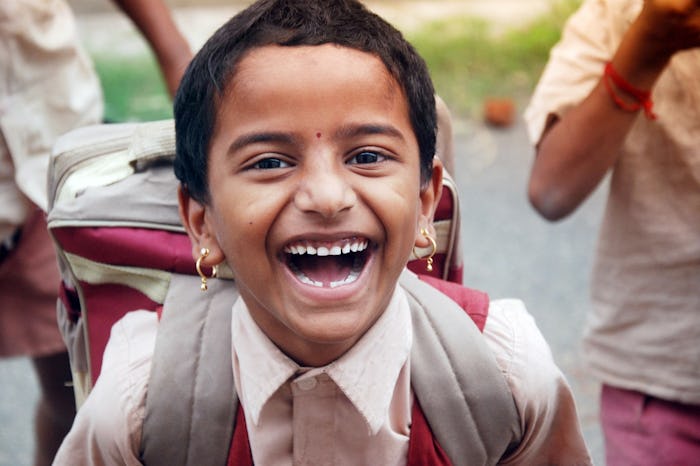Entertainment
13 Children's Books That Help Kids Understand What It Really Means To Be Body Positive
It's been said before, but it's worth repeating: books have the ability to engage children in ways that surpass regular conversations. Literature can offer refuge, escape, and answer private questions. I vividly recall pacing the library, navigating the Dewey decimal system in search of a specific book to explain all the concerns I had about my changing body since I was too nervous to talk to my parents. Regardless of whether or not you and your child have an open line of communication, there are children's books that help kids understand what it really means to be body positive.
Teaching your child how to love the skin they're in, regardless of what standards society sets for gender, race, or orientation, is perhaps one of the most important life lessons you can give your kids. Plus, by letting them discover insightful and meaningful perspectives through literature, you're providing them with a safe space to explore ideas and concepts about body positivity on their own terms.
Whether you let the stories do all the talking or you use them as conversation starters is entirely up to you, but either way, there are some truly helpful books that encourage children to celebrate body positivity.
1'George' by Alex Gino
In George, the title character knows that she is actually a girl, despite being told by everyone else that she is supposed to be a boy. When an opportunity arises for George to try out for a school play, she goes for the role of Charlotte to show everyone who she truly is. This story tackles a complex topic without being too heavy or daunting and teaches children to love themselves inside and out.
2'Amanda's Big Dream' by Judith Matz
For any girl who has been told she is not dainty or delicate enough, Amanda's Big Dream shatters standards of size and shape by showing how Amanda can be a graceful figure skater and be proud of her own figure at the same time.
3'El Deafo' by Cece Bell
In this semi-autobiographical book, the author tells the story of a girl who overcomes insecurities and stands up against bullying because of her very visible hearing aid. El Deafo gives children with visible differences a body positive hero to emulate.
4'I Like Myself!' by Karen Beaumont
As you would expect with a book called I Like Myself!, the entire message aimed at children is to embrace and celebrate every single thing about themselves inside and out—and appreciate differences in others.
5'Your Body Is Awesome: Body Respect For Children' by Sigrun Danielsdottir
Not only does Your Body Is Awesome talk about body positivity, but it also covers topics of respect, consent, and bullying. This is an especially brilliant story because it is aimed at a younger audience and handles topics in a simple way.
6'M is For Mohawk: An Alphabet Book of Fresh Hairstyles' by Dr. Tamara Pizzoli
An important part of body positivity is learning to love all aspects of yourself, including your hair. M Is For Mohawk covers a variety of hairstyles worn by people of different races and without a focus on gender.
7'The Skin You Live In' by Michael Tyler
Specifically for young children, The Skin You Live In teaches kids about being body positive by using colorful illustrations and easy to understand text. Ideal for kids of any age and definitely a great conversation starter.
8'Flora And The Flamingo' by Molly Idle
In Flora and the Flamingo, title characters Flora and the flamingo demonstrate that graceful dancing, fun times, and self expression can be enjoyed regardless of shape or size. Even more interesting is the fact that this story relies only on pictures, not words.
9'Shapesville' by Andy Mills
Sometimes it's easier to approach difficult topics by using fantastical characters. Shapesville is set in an imaginary, small town, citizens of all shapes and sizes get along swimmingly because they don't focus on external differences.
10'Wonder' by R. J. Palacio
Wonder tells the story of Auggie, who is born with a visible facial difference. He has a hard enough time accepting it himself and things get even more complex when he starts attending a mainstream school and encounters a variety of people. The underlying message is one of empathy and body positivity.
11'I Love My Hair!' by Natasha Anastasia Tarpley
Aimed at a young audience, I Love My Hair! teaches children not only to embrace everything about themselves, but to also appreciate the cultural significance of their style and heritage.
12'Our Stripy Baby' by Gillian Shields
Set in a fictional world where people have spots, one day a baby is born with stripes instead. Our Stripy Baby is vague enough to apply to a wide range of topics such as being born with special needs, different abilities, or simply not blending in with the majority.
13'Red: A Crayon's Story' by Michael Hall
In Red: A Crayon's Story, the title character, Red, knows they are actually Blue, despite their external appearance. When Red tries to explain that they know they are Blue instead, not much encouragement is offered. But in the end, Red's friends see the truth and help everyone embrace the new and true Blue.
